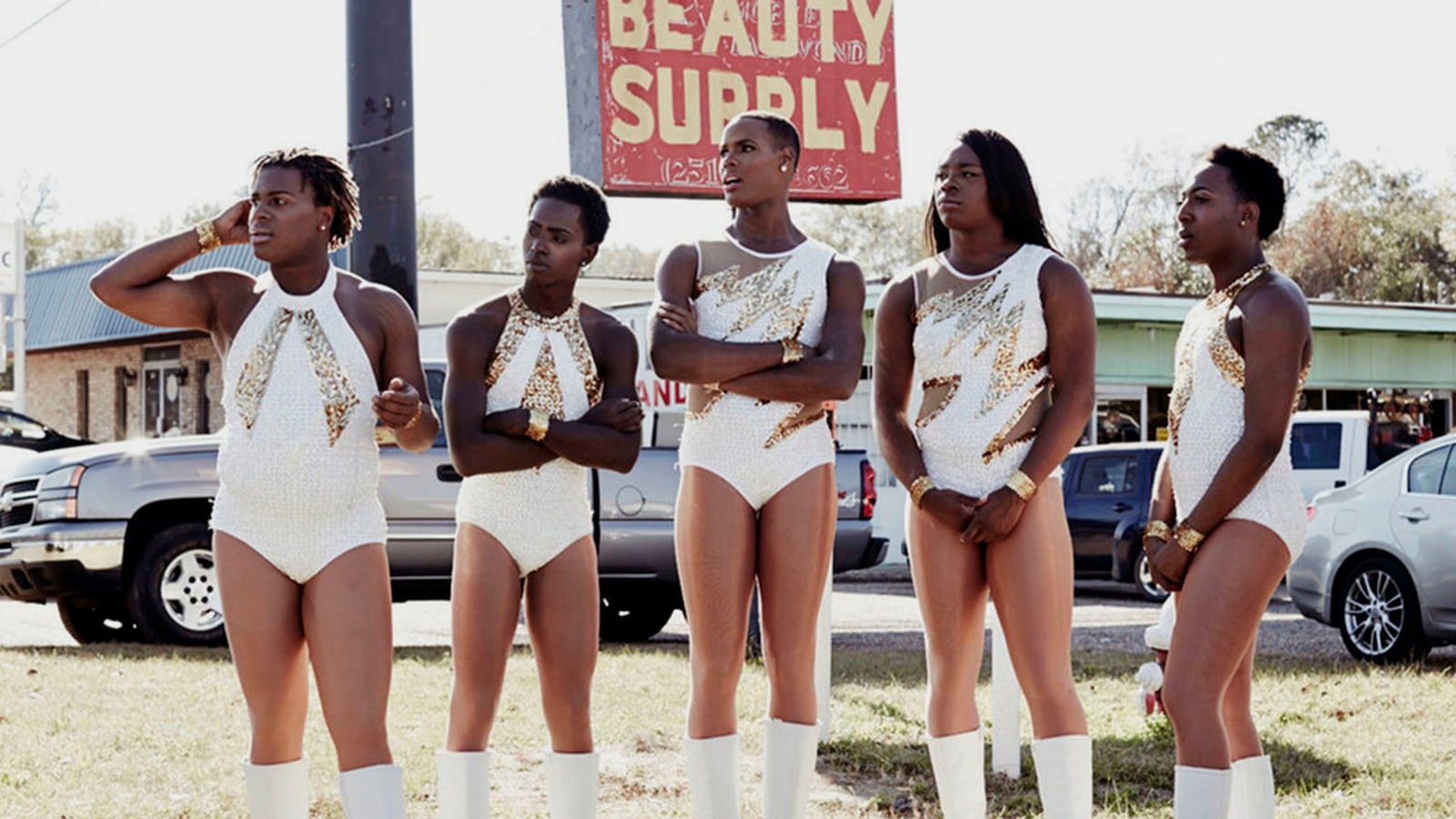For all the reality TV trash that clogs the television garbage chute—but that we, god and Kris Jenner help us, can’t stop watching—it’s a rare pleasure when an offering in the genre comes along that makes you feel good about tuning in.
In a medium that reduces human connection to hashtag battles of whose #Team you’re on when it comes to flipping tables and weave-pulling scrums (or, as in last week’s stress-inducing episode of Real Housewives of New York, the proper etiquette for inviting someone to brunch), there’s a show that attempts to unite instead of divide—and for the purpose of inspiration and human decency, to boot.
So comes The Prancing Elites Project, the imperfect diamond of a new reality series from Oxygen in a sea of otherwise gaudy costume jewelry. The docu-series, which debuts Wednesday night and has already roused heaps of interest on social media with its trailer alone, is a video diary of sorts chronicling the struggle of an unorthodox dance team to be accepted by a community that typically meets their flamboyant choreography not with applause, but with the judgmental clutching of their crucifixes.
The brave dancers who make up the Elites—“brave” is a term often flippantly ascribed to public figures when they do dumb shit like film a movie without makeup, but in this case justly applies—are five black LGBT men (one identifies as transgender) based in Mobile, Alabama.
The Elites perform a type of choreography called J-Sette—a hip-hop meets cheerleading style of dance born from the moves of Jackson University’s marching band dance line and popularized by Beyoncé in the “Single Ladies” music video. They’re often costumed in fabulous glittery leotards, and painted in a spectrum of glamorous makeup, depending on the member.
Their story, already, is an implausible and astounding one. After skyrocketing to viral fame when Shaquille O’Neal tweeted a video of them performing at a basketball game, here is a dance team made up of gay men in women’s leotards and heels grinding to Beyoncé songs who have, in many respects, flourished in the Deep South.
But the mission that The Prancing Elites Project seems to be on, at least based on Wednesday night’s first episode, is to show that while retweet-happy celebrities, open-minded social media mavens, and the occasional event planner in liberal locales across the country enthusiastically embrace the troupe, back at home in highly conservative Alabama, it’s still hard out there for a non-gender conforming male dancer in thigh-high boots.
There’s little nuance to The Prancing Elites Project, which probably fits, considering how loudly the Elites themselves live their lives.
Their crusade for acceptance is portrayed as infallibly noble, as it should be, and anyone who boos them, heckles them, or insinuates that what they are doing is immoral is shamed by the cameras. Again, arguably, as they should be.
At a time when many of us proudly sit on our LGBT-friendly high horses that gallop through fields where same-sex marriage is not just legal, but overwhelmingly gaining support, and talk about how much we love Jamal on Empire and congratulate each other on how open-minded and accepting we are, the Prancing Elites test the limits of that acceptance.
“Normalization” is the word du jour, in pop culture and in life. Gay is OK because Johnny over there in HR is gay and you wouldn’t know it by the way he dresses and it certainly doesn’t define him. But the Prancing Elites force their audience to confront their flamboyance—and their joy—and to be OK with that, too. As it happens, Shonda Rhimes doesn’t currently having a group of men dancing in parades in leotards on any of her series. The response to the Elites’ dancing and their mere existence, then, isn’t always one of acceptance.
The first episode follows their attempt to be allowed to march and dance in a local parade. Their application is turned down because the family-friendly event is not hospitable to what planners rule is the family-unfriendly behavior of guys in makeup dancing. There’s crying. “I just feel like I have this disease that no one wants to be around,” Adrian, one of the team members, says.
And then there’s defiance. They decide to perform at the parade anyway.
When they arrive, looking fierce in their white bedazzled leotards and dancing in perfect unison, they are told they are going to hell, reassured that they are abominations, and scowled at, grimaced at, and cringed at by countless bystanders.
“I hate that people look at us the way they do,” says Tim. “This is what it takes to be a Prancing Elite,” says Kareem. “You have to be able to do deal with all that and carry yourself in an elite manner.”
No sooner does Kareem say that then the group is approached by a woman who, with tears in her eyes, tells them how heroic and special they are. A little girl weeps as she tells them it breaks her heart to see how people treat them: “They shouldn’t have done that to you.”
To the more jaded, the series may come off as inspiration porn. That’s because, in many ways, it is.
If you’re watching The Prancing Elites Project, it’s probably because you’re among the fraction of the world who finds the talented dancers to be fierce and fabulous. It’s probably because you are eager to wag your finger at the so-called Southern bigots who disapprove of them. And it’s probably because you want to cry your self-congratulatory tears when the Good Guys come and defend them.
There is ample occasion for both the finger-wagging and the tearful patting on the back. And there is validity to some worries that the Elites would be turned into a gay twerking reality TV zoo exhibit, dancing in their cages for a round of applause and the cause of enlightenment.
But what not only saves the show, and turns it into important viewing, is the authenticity of the Elites themselves.
These guys are so freaking likable.
They’re talented as hell, and even goofier. They’re unabashedly unrefined—one hilarious scene at a restaurant finds them unsure of what “soup du jour” means, confused when they’re asked how they want their burgers prepared, and baffled by the difference between provolone and gorgonzola. They’re endearingly in love with each other. They’re great TV.
It’s so often the case in reality TV that sob stories are exploited to emotionally manipulate the audience, crocodile tears from people whose biggest challenge in life is their gluten sensitivity. Here are people with sob stories, sure. But their woes derive from being told they can’t be who they are.
Worse, they’re not allowed to dance. It’s gay goddamned Footloose.
So much of reality TV thrives on the audience cringing at the people on screen. These are people who are actually fun to watch.
More, they’re aware of the significance of what they are trying to do—change minds, promote acceptance, and send the message that there’s no shame in being who you are—and the powerful simplicity of the way they want to go about doing it. As team captain Kentrell says, “We just want to dance.”





